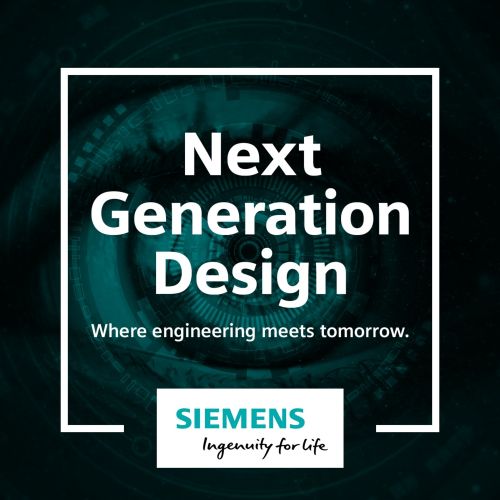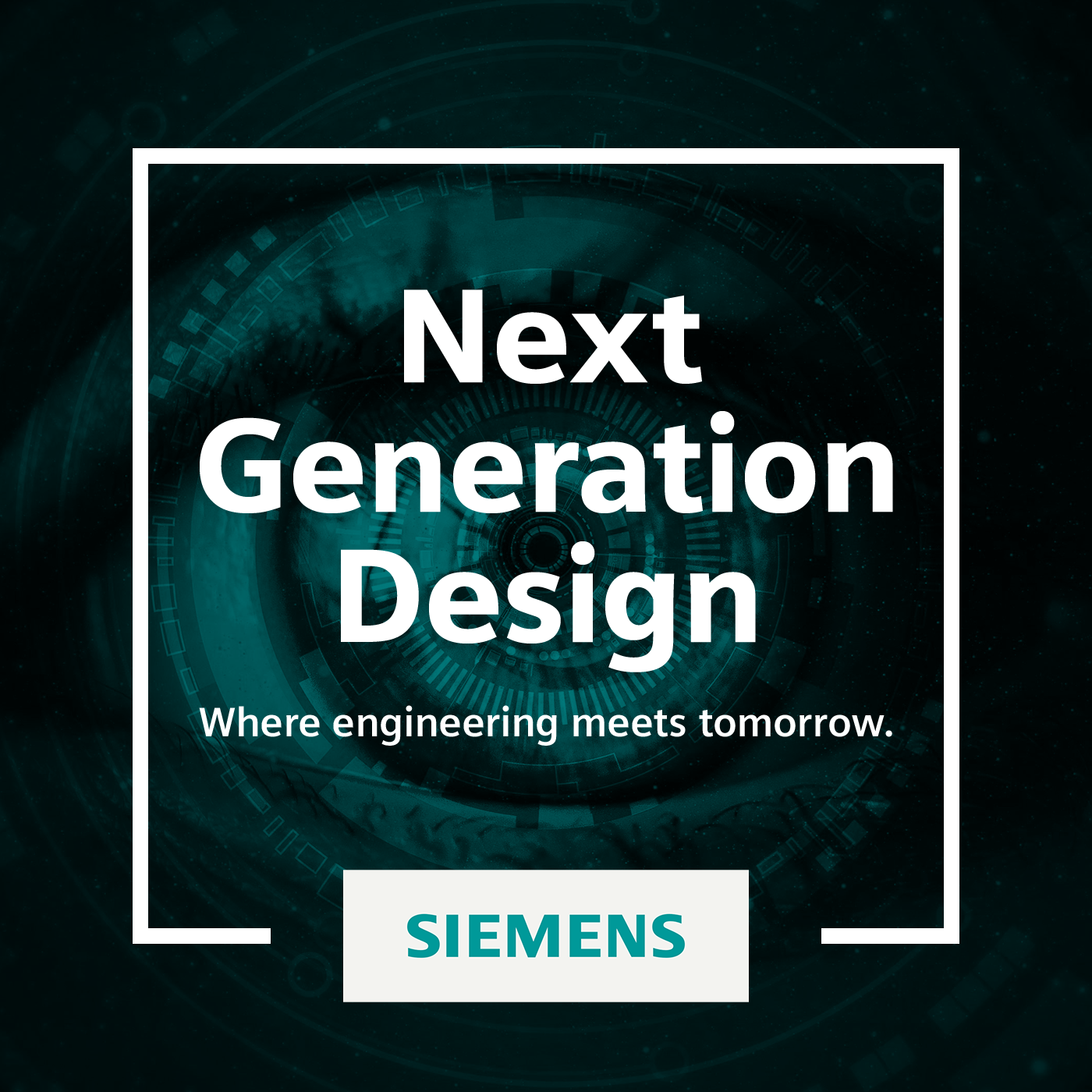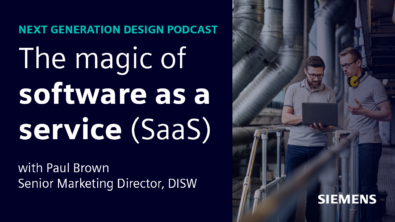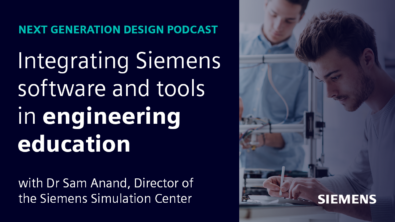Collaborative Design Management – A Backbone for Communication

A business with a successful collaborative design management process in place is able to say, “I know exactly where my information is”, “I know how to access it” “I know it is secure” and “I know it is backed up.”
Summary
The world of Collaborative Design Management is vast and we’ve only hit the tip of the iceberg in what can be done with these processes.
In this episode I’m joined by Gary Lindsay, Product Manager at Siemens Digital Industries. We discuss what Collaborative Design Management is all about, how it’s been integrated into its field, as well as some emerging and evolving trends within the space.
The area of Design is one that encourages its engineers to adapt to the world around them. Finding ways to implement targeted practices that are diverse and separate from traditional methods is the most effective way we can engage our consumers and ensure we are staying up to date as creators.
If you’re interested to learn more about this ever-growing industry and get some well-rounded insights from an expert in the field, then have a listen to Episode 6 of Next Generation Design!
Some Questions I Ask:
- Could you define what Collaborative Design Management is? (2:11)
- Where are you seeing this technology being adopted in other industries? (9:21)
- Where do you see Collaborative Design Management going in the future? (21:13)
- How can my listeners connect with you and the Siemens team for more information on this topic? (24:18)
In This Episode You Will Learn:
- Background on how Gary Lindsay ended up in the Data Management space (0:41)
- How to facilitate the concept of reusing in the Collaborative Design space (6:51)
- Examples of design trends & How they have evolved (10:38)
- A breakdown of Change Management and communication (11:39)
- Ways to start implementing Change Management into your business (15:00)
Connect With Jennifer Piper:
- Siemens Digital Industries – Website
- Siemens Digital Industries – Facebook
- Siemens – Twitter
- Siemens – Instagram
Connect With Gary Lindsay:
As product complexity grows, manufacturing is introducing new ways to produce parts and bring products to market. With these changes bring upon new challenges when it comes to designing those parts and the collection and dissemination of accurate data along the way. Changes to:
- classification systems
- consumption of library parts
- traceability
- workflows that introduce status and trying to gain a better understanding of where your products are within their lifecycle.
and that’s just the beginning of a very long list.
In this episode of the Next Generation Design podcast, we discuss collaborative design management systems and the benefits they provide not only to the end user but the matter of business as a whole.
Being able to the watch the lifecycle of the information from product design, new product introduction, through putting it into service and then maintaining it – allows for the constant optimization of processes at hand.
If we can find something we have already qualified, and we have already done simulation, manufacturing, and maintenance on it, would it be in our best interest to reuse it? At times the answer is a resounding yes, but If we lock it up and hold it to ourselves we are doing a disservice to the productivity of business.
Listen in to this episode of the Next Generation Design Podcast, and learn more about collaborative design management systems, the types available and the steps to take in when exploring the implementation of a system.
Jennifer Piper: Welcome back to another episode of the Next Generation Design podcast series. I’m your host, Jennifer Piper. The design process has many different moving parts. Think about it, when you’re trying to create something new, you have a lot of thoughts going on in your head: you have a task at hand, you have your idea to fulfill that task, and you have all the versions and trails you try out along the way to get to the final product. All of this information has to be organized somehow. And where there’s organization, there’s usually someone doing all of the organizing.
Gary Lindsay: I started my career in aircraft design, graduated from Wisconsin. Aircraft design for six years and then moved into more of an area that had better longevity and eventually got me into the data management space and looking at managing the content that generally comes out of design engineering. I started with products where they were really pioneers in bringing not only collaborative but bringing a fully integrated design management solution to market. And it really was the first that made transparency seamless – that integration between the two. There were some opportunities in managing that information and upgrading those systems, and that was really where I started more on the software side, moving out of your traditional mechanical design and into more of the software space. And then, I had the opportunity to join EDS back in the time and here we are today, at Siemens – and I made my way from presenting CAD solutions and data management, into being able to be on the product management side, interacting with customers to gather requirements and looking at our future opportunities to deliver those to them.
Jennifer Piper: That’s Gary Lindsay – he’s our guest on today’s show. He’s going to help us understand the nuts and bolts of the collaborative design management process, especially one in the technology industry. So, I guess to get started, I think it would be very helpful for you to define, really, what collaborative design management is.
Gary Lindsay: So maybe we break that down first and take a little bit on the side of what it means for a person maybe in the CAD space – we start there in the design side – working to manage their information, and what are some of the benefits that we hope to gain from just the management of the information. And so, typically, we hear words in the day of vaulting and check-in and check out. And the idea is, first we need to be able to gather all the information that’s used in the design process and know where that is. So, the vaulting piece is the first piece where someone – our management – would be able to say, “I know exactly where my information is. I know it’s secure and I know it’s being backed up.” The other capabilities that are usually introduced into that conversation is version management, and then ultimately into maybe revision management. So, each time I submit a change in a file to the system, the system captures that as a version. If there’s a reason to go back, I have the opportunity to go back. And then, really, it’s a matter of how much space do we have to manage all of our engineering information. And hopefully, that isn’t the gating factor in deciding to get rid of that rich information but maybe that’s part of the lifecycle as to when you purge off the old versions and when it really is valuable to have that information. The revision management is really around the ideas of watching the lifecycle of the information – and we might get into a conversation then around the lifecycle of product design, a new product introduction, through putting it into service and then maintaining it. So, ideation to production, to maintain – really looking at that lifecycle. So, revision and the ability to revise our product design is important as we look at the product lifecycle.
Gary Lindsay: So, once we have the design management kind of understood, then, how do we go faster? We could go faster, perhaps, by introducing additional engineers or designers to the product in order to hope that we can segregate it and go faster. And so, we need to be able to work cooperatively in the development of the product. And that’s really where the system comes and could shine, is that, you know, is it doing everything to give the folks using the system the feedback that they need to know that they’re working with the latest information? And, in fact, if they’re more like a simulations person, there may be use cases where you want to hold on what you have to get your baseline to be evaluating the changes that are coming in the product. So, it’s not always that I’m with the current – I certainly need to know where I am with respect to the current. And then, we can step off and take a look at that.
Gary Lindsay: In today’s market, some of the collaboration is also not within the same geographic location. So, another part of collaboration that we’re starting to see today is the expanse and recognition that people don’t need to be co-located to be successful in building products and taking them to market. So, we’re looking at solutions that effectively help geographically-distributed design groups finish their products. And so, that is another emerging element that’s been there for a while, but we certainly see it coming much more prevalent in this space today. It really is just the tip of the iceberg, the few of the capabilities that I’ve described. I’m not one who likes to take a look at a matrix of features and functions and get a checklist as to help people do this. In my view, it really does, at least, have the capabilities you believe you need to step forward. And then, to put those into practice, do a proof of concept and validate that what they’re saying is, in fact, allowing you to go faster to meet your objectives. And that really is where, in my opinion, the rubber meets the road. Is it, in fact, enabling me to go faster? If it’s not, are all the other business things that are very important to me being fulfilled as a result of them working in the system? So, not always do we simply go faster than what we would have without a system like this, if you will, without a net? It really is a matter of the overall business benefit, not just the end-user. But, hopefully, everybody is benefiting from the system in this solution.
Jennifer Piper: Gary tells me that this kind of management isn’t necessarily new. However, as the designs and technology advance, the process changes too, in order to keep up.
Gary Lindsay: One more topic related to the design, one more value proposition for the design side is, now that we’ve gathered all this rich information, what can we do to facilitate reuse? The thought is that if we can find something that we’ve already qualified, we’ve done simulation on, we’ve delivered, we’ve gotten maintenance information, warranty information on it, would it be in our best interest to reuse that whenever possible? Now that we’ve captured it, we’ve got it vaulted, we know that it’s safe, we know that we can revise it, we know who is working with it, can we start to disseminate this information to other people, as well? So, the next piece, now once we’ve gathered it, we’re using it internally, and then we provide it to those people that need it when they need it. So that’s the key piece.
Gary Lindsay: We want to be able to start to show or present particular design elements as they become available. So, there might be some long-lead items that need to be procured in advance of actually being able to put it on a machine and cut it. So, now we start taking a look at our interactions with downstream consumers like manufacturing. We wouldn’t have a product if we couldn’t build the product. Some of those benefits, then, come down to knowing that we have the right drawings, knowing that we’ve communicated those drawings to the consumers and they’re working with the correct data, perhaps even looking at tying in the shop floor to some of this rich electronic content so we’re not printing papers, and so that they have a way of consuming that directly. Also, perhaps some tools. Ideally, you might think it’s bad practice not to have all the information already on the drawing phase but if for some reason they needed access to information then maybe get that one extra dimension, or if they’re validating a coordinate measuring machine, they’re validating the product, they’re in inspection, that they have access to maybe some tools that necessarily aren’t awarded with a piece of paper. So, those are the kinds of things that we’re looking at fulfilling. If we just lock it up and hold it to ourselves, we’ve done a disservice. We really want to look at who needs it, and make sure that we’re giving it to them when they need it.
Jennifer Piper: Where are you seeing some of the industries adopting this technology?
Gary Lindsay: So, this is not necessarily new. But, how does the industry – the changes in the industry – drive what we do to adapt and provide maybe something they need that they wouldn’t have already had? So, industry trends and adoption? So, we see our designs are getting more complex and manufacturing is introducing new ways to produce parts and bring products to market. So, we hear words like adaptive manufacturing. On our side, are we doing all we can to capture the design intent and be able to communicate that downstream to manufacturing? Are there other formats than the native CAD system format that we need to manage in order to provide that downstream? So, bringing CAM – our manufacturing folks that are creating Toolpath – into the system early, allowing them to take changes easily, would be a benefit as well. So, we know parts change and so, if we can help facilitate that in their process, that would be wonderful as well.
Gary Lindsay: We’re seeing classification systems and changes within classification to help, again, maybe the findability, but maybe also in downstream or conveying this to other people. That’s an important part of what we watch as well, and certainly, one that continues to evolve. We see also opportunities perhaps in reuse around consumption of library parts of catalog parts. So, these have been around for a long time. But can we bring those into our ecosystem and use them effectively? There’s also the idea that they need to be qualified, if you will, cleared – that they’re a viable component to use in your products as well. So, there could be aspects associated with that, where going out to a bureau to pick one off, albeit very easy, may not be the right process for some organizations.
Gary Lindsay: We also see increases in traceability. So, we see a variety of things coming that way. One of the things that we like to think about as you’re moving from traditional CAD vaulting to try and expand this into a more effective collaboration platform, is taking a look at change management – and it might be as simple as workflows that introduce statuses and trying to gain a better understanding about where your parts and products are within their lifecycle, so that you can communicate that, make it very easy for the consumers to understand where they are. Again, targeting the right content to the right audience at the right time. Change management might be something a little bit bigger than simply a workflow – and that’s a formal process, where you’re capturing reasons for change, and you’re planning those changes. You’re looking at the impacts that those changes have on the rest of the organization, and may even flow down to manufacturing asking questions about what do we have in inventory? And will this change adversely affect the bottom line with respect to inventory? So, Change Management is the backbone to communicate change, to introduce and also to put through, to notify people that something is undergoing change. So, also from an ordering aspect to know that we’re not ordering content or ordering parts that we know that are going to be changing soon.
Gary Lindsay: So then, also complexity, but also what we might call multidisciplinary. So, we traditionally have had mechanical systems that weren’t crazily smart, weren’t intelligent. And every system now is some electrical mechanical system. They’re introducing wiring, they’re introducing electronics, and now they’re introducing software and software upgrades. So, we’re seeing that as a growing and expanding part of what we do, is our ability in the traditional mechanical design space to be able to speak and exchange content with our brothers that do e-CAD. That is another big area and opportunity for collaboration.
Gary Lindsay: Our products – we’re also looking to go faster so, we’re thinking about ways that not only reuse but can we configure those products to then offer something that is at least marketing-wise, new? So, can we get something out to the market that looks different, has some new features – maybe a software upgrade that does some other cool things? And can we configure those products? So, you start to take a look at some of the websites. Bose is an example of one that I went to recently – and they have the opportunity for you to configure the color of your headset. They offer some examples. So, again, is part of a social network, they look and see what’s trending and then offer some of these often-ordered configurations. They offer those as, “Well, maybe you want this. Or start with this and make changes.” So, product variations, product variants, ways to engage consumers to come and buy your products. And can we use configuration and configurators to help us optimize so our return is as high as we can make it?
Jennifer Piper: It makes sense, right? In order to stay efficient with the changing technology, the way we manage that technology has to change. Even though these changes come often, getting a start in collaborative design management isn’t as intimidating as it might sound.
Gary Lindsay: Today, they have so many more options about how to start than we might have had even a few years ago. So, we see solutions coming available, where you can dip your toe and get started. And then, depending upon your experience with the solutions, perhaps continue to invest and grow as they, if you will, take you upscale and start to introduce. So, I don’t always like associating small to medium businesses with introductory type solutions. I really like to take the approach that it’s the complexity of the products that they’re working on that drives the requirements in this area, and perhaps the prioritization of those. So, to get started, perhaps the first place to look is, what are the cloud-based solutions offering today that might be appealing? And why that first?
Gary Lindsay: So, cloud-based solutions might give a small customer – or a customer trying to test the waters in this area – a lower cost to entry solution. Part of this is there could be re-engineering required within your organization to realize this return on investment. You can’t simply just drop in one of these very capable systems into existing processes and think that you’re going to get 100 miles an hour from them. So, there has to be the recognition that adjustments need to be made in order to recognize the true value of the proposal. And so, maybe a cloud-based solution might be a way to get started. Use your traditional desktop authoring systems with a cloud complemented data management system and look at starting your vaulting – perhaps that also helps address maybe some geographically distributed challenges that you’ve had – or even try to enable designers who like to go home and do more work. Allow them to take their work home with them. I know that might sound not so good for some of us but for those that are really, really engaged in learning, what they’re doing, it could be an advantage.
Gary Lindsay: So, recognize that not all of our workforce has the same capability and enabling some of the young people, or the people that are new to the technology, the opportunity to learn at their own pace could be a good thing. So, Cloud might be a place to start – your desktop applications talking to cloud-based solutions, getting you introduced to the whole idea of managing the information. And we didn’t talk about it at the beginning but, certainly, one of the enablers folks look at is a common naming convention. We used the word ‘classification’ earlier. Classification is there to provide that consistency across content that serves the same purpose perhaps – and your ability to find it. But there is a naming convention that could be a benefit. So maybe a non-intelligent part number, but you have some other properties that you gather that helps you with the findability. Again, facilitating reuse. So, those might help you get your direction, might set the stage for you to get started and understand some of the elements that you would want to consider as you implement a solution.
Gary Lindsay: Once you’ve exhausted the capabilities that might be offered in the cloud, we can go to some solutions that offer more capability but may still be managed outside your organization. So, we might think of something like a managed solution or we hear the term ‘Software as a Service’ – SaaS. So, now, I’m still sitting at my desk using my desktop applications, and instead of talking to the cloud in maybe a cloud-based offering, I’m talking to the cloud in a managed service, private cloud kind of way. And now I’ve introduced more technology, more capability beyond what I had in my initial offering. I’ve moved up, if you will, and I’m starting to consume. I’m a believer in change management. I’m a believer in configuration management and I want to start to take advantage of those capabilities. And so, I want to move to the right and up, and I want to take advantage of these.
Gary Lindsay: Now, for those who feel that their content needs to be on-premise, the solutions that might be offered as managed solutions are certainly available to them to install within their organization, and start to take a look at, perhaps, servicing geographically-distributed workforces as well. Those would be available to get started as well. The SaaS might be an interesting way to get started – again, as some of the business benefits of not having to pay all the money upfront. And then the maintenance – perhaps your barrier to entry is a little lower, you can get started, you can evaluate, you can grow, at which point, you may find that that is exactly what you want and continue down the path. But that would be an opportunity as well. Perhaps, there would be some opportunity if you wanted to convert that to more of a perpetual license. But, generally speaking, we start to see this move from a perpetual license, something that you own, to something like a software as a service solution – you pay for use, pay for an annual subscription and you continue to use that and all of the benefits of data management that could go with that.
Jennifer Piper: I know we talked a lot about the capabilities and how companies can get started and the different industry trends and adoption. But, where would you see the future vision of collaborative design management going, say, five to 10 years out?
Gary Lindsay: It’s a good question! I think we’ll see the continued adoption of cloud solutions. We believe you’ll see some more cloud-native solutions coming online, as well, to start to facilitate those who have embraced it. My own opinion is there are some who are not believers in the cloud. I think we’ll see for a long time on-prem solutions – certainly, for those that are in markets where they just can’t put that kind of content in a cloud, no matter whose cloud it is; those will be there. I think what we’ll see maybe more is cloud hybrid solutions, taking a look at ways that they can start to connect their traditional on-premise solutions with other capabilities that might be cloud serviced or cloud offered, and start to see interesting opportunities there as the two come together. And that might be the next opportunity to give those who aren’t yet comfortable with cloud-only solutions, the opportunity to validate it, watch the market mature, and move forward.
Gary Lindsay: The workforce is continuing to evolve and change. We see policies within Siemens recognizing that that is happening. The next generations, the younger generations are seeing changes in the way they work. They want to work from home, they want to work from the coffee shop, and if we enable them to just be able to work anytime and anywhere, we might, as an employer see an opportunity. Certainly, they’re continuing to learn. And so, if we can empower them to learn more, they bring that idealization to the company and we get bright new ideas to help us bring new products to market. So, if we can empower our workforce to be able to work wherever they are, you know, geographically distributed, and also provide them tools to stay connected – we see a lot of that going on today – we might start to see more of these social tools starting to come into our traditional brick and mortar type MCAD systems, where we can start to do more live collaboration while we are not in the same office, not looking over the shoulder, and continue to do the mentoring that we’ve all benefited from in our careers. It’s going to be interesting, but I think we’ll see a lot of what we have today, and it’ll be an interesting complement. We might also see that the adoption is going to be very much industry-centric. We might see some industries who have very unique competitive situations be adopters of technology and these capabilities, perhaps a little faster than others.
Jennifer Piper: If some of our listeners wanted to get more information on collaborative design management, where could they connect with you, or with the Siemens team online?
Gary Lindsay: So, where would people go to get more information? I had an example yesterday where I was asked, “What kind of information do you have that can tell me about the Siemens CAD systems and our ability to manage that information with your Lifecycle Management Solutions?” The information on the website is an excellent place to start your exploration and your research. And, in fact, there is a collaboration link that will get you to a point where you can look at mechanical design management, interestingly enough, and you can start to dive into the solutions that are offered by Siemens to manage Siemens CAD data, as well as managing other CAD systems data. And you can move off from that and start to take a look at the electromechanical design, you can start to take a look at the work that’s being done in the multi-disciplinary areas, start to take a look at if manufacturing is an element that you want to introduce to your solution and see how those start to come in, product simulation – are all very important in bringing a product to market. There are also forums, communities that you can participate in. You can certainly be a more stand-back-and-watch-what-happens or you can choose the amount of participation that’s comfortable for you. I like to participate in the NX Design and Data Management – we’re active there and watching the community as they start to ask questions. It is an exciting time. Our product Refresh is increased to be in a six-month cadence. So, it feels like, for us, in product management, we are always having the opportunity to talk about what we just did, what benefits we believe those have, and how they might introduce those into their solution. So, there is that opportunity to stay current, but at least you can see what’s happening and you can plan when you step in.
Jennifer Piper: Thanks to Gary for coming on the show and talking about collaborative design management with us. And thank you for joining us today, on this episode of the Next Generation Design podcast. I’m Jennifer Piper.
Jennifer Piper: Siemens Digital Industries Software is driving transformation to enable a digital enterprise where engineering, manufacturing, and electronics design meet tomorrow. Our Xcelerator Portfolio helps companies of all sizes create and leverage digital twins which provide organizations with new insights, opportunities, and levels of automation to drive innovation. For more information on Siemens Digital Industries Software products and services, visit www.sw.siemens.com or you can also follow us on LinkedIn Twitter, Facebook, and Instagram. Siemens Digital Industries Software – where today meets tomorrow!

Next Generation Design
As product engineering tools continue to morph and expand at speeds human expertise may not be able to endure, Revolutionary design technologies that span beyond industry borders, will prove their necessity for companies looking to take over their markets in the future. What will the future of design technologies and machinery look like? What will your digitalization story be? Where engineering meets tomorrow.

Next Generation Design Podcast
As product engineering tools continue to morph and expand at speeds human expertise may not be able to endure, Revolutionary design technologies that span beyond industry borders, will prove their necessity for companies looking to take over their markets in the future. What will the future of design technologies and machinery look like? What will your digitalization story be? Where engineering meets tomorrow.


